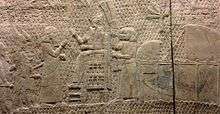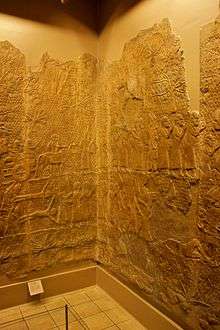Lachish reliefs
The Lachish reliefs are a set of Assyrian palace reliefs narrating the story of the Assyrian victory over the kingdom of Judah during the siege of Lachish in 701 BCE. Carved between 700-681 BCE, as a decoration of the South-West Palace of Sennacherib in Nineveh (in modern Iraq), the relief is today in the British Museum in London,[1] and was included as item 21 in the BBC radio 4 series A History of the World in 100 Objects. The palace room, where the relief was discovered in 1845-47, was fully covered with the "Lachish relief" and was 12 metres (39 ft) wide and 5.10 metres (16.7 ft) long.[2] The Lion Hunt of Ashurbanipal sequence was found in the same palace.


Identification
The reliefs were discovered by the then 28-year-old Austen Henry Layard during excavations in 1845-47. Commenting on the inscription above the seated figure of Sennacherib, Layard wrote:
Here, therefore, was the actual picture of the taking of Lachish, the city as we know from the Bible, besieged by Sennacherib, when he sent his generals to demand tribute of Hezekiah, and which he had captured before their return; evidence of the most remarkable character to confirm the interpretation of the inscriptions, and to identify the king who caused them to be engraved with the Sennacherib of Scripture. This highly interesting series of bas-reliefs contained, moreover, an undoubted representation of a king, a city, and a people, with whose names we are acquainted, and of an event described in Holy Writ.
Layard noted in his work that Henry Rawlinson, the "Father of Assyriology", disagreed with the identification as the biblical Lachish.[4] Rawlinson had written in 1852: "At the same time, it is hardly possible that the capture of Lakitsu, which is figured in the most elaborate manner on the walls of Sennacherib's palace at Nineveh, can refer to this city, as the two names are written quite differently in the Cuneiform characters."[5] Layard and others refuted Rawlinson's identification, and the identification as the biblical Lachish prevailed.
Israeli researcher Yigael Yadin showed that the images of the walls and town depicted fit exactly with the uncovered walls and town as seen from a certain point near the Tel Lachish digs. The descriptions shown in the reliefs were compared with those written about Lachish in the bible and found to be similar as well.[6]
Interpretation
The events surrounding the conquest of Lachish are recorded in an unparalleled number of sources for the 8th century BCE; in the Hebrew Bible, the Lachish reliefs, Assyrian cuneiform prisms and in the archeological excavations at Lachish.[7] Sennacherib's conquests of Judean cities, without the capital Jerusalem, are mentioned in the Bible, the book of Kings, Book of Chronicles and in the book of Isaiah.
"Later, when Sennacherib king of Assyria and all his forces were laying siege to Lachish, he sent his officers to Jerusalem with this message for Hezekiah king of Judah and for all the people of Judah who were there"-(II Chronicles 32:9)
"Now it came to pass in the fourteenth year of King Hezekiah that Sennacherib king of Assyria came up against all the fortified cities of Judah and took them." - (Isaiah 36:1-2)
In his annals, Sennacherib claimed that he destroyed 46 fortified cities and towns of Judah and took 200,150 captives, although the number of captives is seen today widely as exaggeration. He also claimed that he besieged King Hezekiah of the Judah in Jerusalem "like a bird in a cage."[8] Grabbe and other scholars today consider the city pictured on the Lachish relief to be Jerusalem. They point out that since Jerusalem was not captured by the Assyrians, the artist from Nineveh who carved the relief "added simply Lakisu instead of "Ursalimmu" (Jerusalem).[9] Other authors point out that the siege of Jerusalem is not depicted on the Lachish relief because it resulted in failure and the relief was seen as a way of compensation for not conquering Jerusalem.[10] The size of the relief, its position in the central room of his palace and the fact that the Lachish relief constitutes the only battle portrait created by Sennacherib, indicate the importance he gave to this battle and presumed victory over Judah.[11][12]
| Wikimedia Commons has media related to Lachish Reliefs. |
References
- "Room 10b: Assyria: Siege of Lachish". British Museum. Retrieved 2012-10-03.
- "The Lachish Reliefs and the City of Lachish" (PDF). Ericlevy.com. Retrieved 2012-10-03.
- Discoveries Among the Ruins of Nineveh and Babylon, p128
- Layard, footnote to page 129
- Outline of the history of Assyria: as collected from the inscriptions discovered by Austin Henry Layard, Esq. in the ruins of Nineveh (1852), p23
- How to capture a city Professor Israel Efal, Library of the Center for Educational Technology (Hebrew)
- "Jewish History". Cojs.org. Archived from the original on 2013-11-04. Retrieved 2012-10-03.
- Evans 2009, p. 3-4.
- Grabbe 2003, p. 293.
- Grabbe 2003, p. 295.
- Finkelstein 2007, p. 173.
- The King James Study Bible, KJV - Thomas Nelson - Google Books. Books.google.rs. 1999-02-15. Retrieved 2012-10-03.
Bibliography
- Grabbe, Lester (2003). Like a Bird in a Cage:The Invasion of Sennacherib in 701 BCE. Continuum International Publishing Group.CS1 maint: ref=harv (link)
- Evans, Paul (2009). The Invasion of Sennacherib in the Book of Kings:A Source-Critical and Rhetorical Study of 2 Kings 18-19. IDC Publisher.CS1 maint: ref=harv (link)
- Finkelstein, Israel (2007). The Quest for the Historical Israel: Debating Archaeology and the History of Early Israel: Invited Lectures Delivered at the Sixth Biennial Colloquium. Society of Biblical literature.CS1 maint: ref=harv (link)
- Nelson, Thomas (1999). The King James study Bible. Liberty University.CS1 maint: ref=harv (link)
| Preceded by 20: Statue of Ramesses II |
A History of the World in 100 Objects Object 21 |
Succeeded by 22: Sphinx of Taharqa |